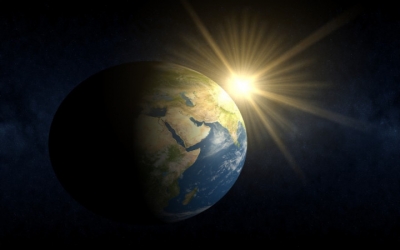
|
Scientists think Earth was formed at roughly the same time as the Sun and other planets when the Solar System came together from a giant, rotating cloud of gas and dust known as the solar nebula. As the nebula collapsed because of its gravity, it spun faster and flattened into a disc. Most of the material was pulled towards the centre to form the Sun. Gradually, the rest of this vast cloud began to cool and the gas condensed into trillions of droplets. These droplets were slowly pulled together by their own gravity and formed clumps. Leftover particles within the disc collided and stuck together to form other larger bodies, including Earth. |
When Earth formed 4.5 billion years ago, it was a sterile ball of rock, slammed by meteorites and carpeted with erupting volcanoes. Within a billion years, it had become inhabited by microorganisms. Today, life covers every centimetre of the planet, from the highest mountains to the deepest sea. Yet, every other planet in the solar system seems lifeless.
Many ideas have been proposed to explain how life began. Most are based on the assumption that cells are too complex to have formed all at once, so life must have started with just one component that survived and somehow created the others around it. When put into practice in the lab, however, these ideas don’t produce anything particularly lifelike. It is, some researchers are starting to realise, like trying to build a car by making a chassis and hoping wheels and an engine will spontaneously appear.
Credit: newscientist
Picture credit: Google



